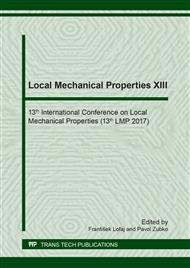[1]
C. Miki, K. Homma, T. Tominaga, High strength and high-performance steels and their use in bridge structures, Journal of Construction Steel Research. 58, (2002), 3–20.
DOI: 10.1016/s0143-974x(01)00028-1
Google Scholar
[2]
A. M. P. de Jesus, R. Matos, B.F.C. Fontoura, C. Rebelo, L. Simoes da Silva, M. Veljkovic, A comparison of the fatigue behavior between S355 and S690 steel grades, Journal of Construction Steel Research. 79, (2012), 140–150.
DOI: 10.1016/j.jcsr.2012.07.021
Google Scholar
[3]
J. Lewandowski, D. Rozumek, Cracks growth in S355 steel under cyclic bending with fillet welded joint, Theoretical and Applied Fracture Mechanics. 86, (2016), 342–350.
DOI: 10.1016/j.tafmec.2016.09.003
Google Scholar
[4]
W. Gao, D. Wang, F. Cheng, X. Di, C. Deng, W. Xu, Microstructural and mechanical performance of underwater wet welded S355 steel, Journal of Materials Processing Technology. 238, (2016), 330–340.
DOI: 10.1016/j.jmatprotec.2016.07.039
Google Scholar
[5]
R. Pawliczek, M. Prazmowski, Study on material property changes of mild steel S355 caused by block loads with varying mean stress, International Journal of Fatigue. 80, (2015), 171–177.
DOI: 10.1016/j.ijfatigue.2015.05.019
Google Scholar
[6]
D. Rozumek, Z. Marciniak, G. Lesiuk, J. A. F. O. Correia, Mixed mode I/II/III fatigue crack growth in S355 steel, Procedia Structural Integrity. 5, (2017), 896–903.
DOI: 10.1016/j.prostr.2017.07.125
Google Scholar
[7]
O. Adedipe, F. Brennan, A. Kolios, Review of corrosion fatigue in offshore structures: Present status and challenges in offshore wind sector, Renewable and Sustainable Energy Reviews. 61, (2016) 141–154.
DOI: 10.1016/j.rser.2016.02.017
Google Scholar
[8]
EN 10025-2:2004 Hot rolled products of structural steels - Part 2: Technical delivery conditions for non-alloy structural steels.
DOI: 10.3403/30239477
Google Scholar
[9]
European Committee for Standardization (CEN). EN1993-1-9: Eurocode 3: Design of steel structures, part 1-9: Fatigue. Brussels. European Standard. (2005).
Google Scholar
[10]
American Society for Testing Materials. ASTM E647: Standard test method for measurement of fatigue crack growth rates. Annual Book of ASTM Standards. 3(1) (1999), 591–629.
Google Scholar
[11]
P. C. Paris, F. Erdogan, A critical analysis of crack propagation laws, J. Basic Eng. 85, (1963), 528–533.
DOI: 10.1115/1.3656900
Google Scholar
[12]
A. Fernández Canteli, C. Przybilla., M. Nogal., M. López Aenlle., E. Castillo., ProFatigue: A software program for probabilistic assessment of experimental fatigue data sets, Procedia Engineering, 74, (2014) 236–241.
DOI: 10.1016/j.proeng.2014.06.255
Google Scholar
[13]
E. Castillo., A. Fernández-Canteli, A unified statistical methodology for modeling fatigue damage, Springer, (2009).
DOI: 10.1007/978-1-4020-9182-7_7
Google Scholar
[14]
E. Castillo, A. Canteli, D. Siegele, Obtaining S-N curves from crack growth curves: an alternative to self-similarity, International Journal of Fracture, 187 (2014) 159–172.
DOI: 10.1007/s10704-014-9928-6
Google Scholar
[15]
Z. Kala, Identification of stochastic interactions in nonlinear models of structural mechanics, AIP Conference Proceedings, (2017) 1863,480004.
Google Scholar
[16]
Z. Kala, A., Omishore, Fuzzy stochastic approaches for analysing the serviceability limit state of load bearing systems, International Journal of Mathematics and Computers in Simulation 10 (2016) 294-301.
Google Scholar
[17]
M. Krejsa, Z. Kala, S. Seitl, Inspection based probabilistic modeling of fatigue crack progression, Procedia Engineering (2016) 145-152.
DOI: 10.1016/j.proeng.2016.02.025
Google Scholar
[18]
M. Krejsa, L. Koubová, J. Flodr, J. Protivinsky, Q.T. Nguyen, Probabilistic prediction of fatigue damage based on linear fracture mechanics, Frattura ed Integrita Strutturale 11(39) (2017) 143-159.
DOI: 10.3221/igf-esis.39.15
Google Scholar


